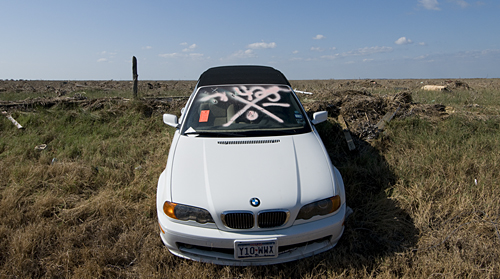
Hurricane Ike – Galveston Island – Part 2
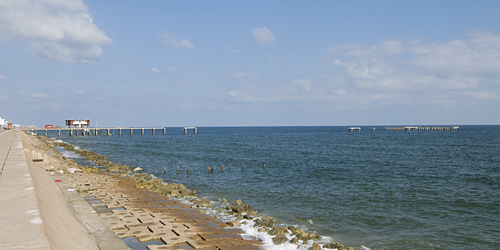
Pier is now chopped apart.
Now on the Island, there is a buzz of activity as workers from all over the United States work to gather up the bilge left behind by Ike. There is debris of every dimension, from medicine bottle caps on the beach, to shrimp boats in parking lots. Although was apparently 500-thousand gallons of various fuels spilled into the water, I saw no evidence of oil or “slicks” on the water from the vantage points on the island and looking across the harbor toward the production facilities. It may be out there somewhere, but I didn’t see that “drop in the ocean”. The USO, FEMA and the Salvation Army, along with many, many more organizations (without the readily identifiable vehicles), sit parked in the old downtown and all along the way down the island toward the San Luis Pass (SLP). Complete subcultures are in place – tent cities full of workers with every level of skills – there until the job is done, for profit. Stories of the profits from Hurricane Katrina (trailer loads of debris at 2-thousand each for a certain volume trailer) fuel this new disaster based economy.
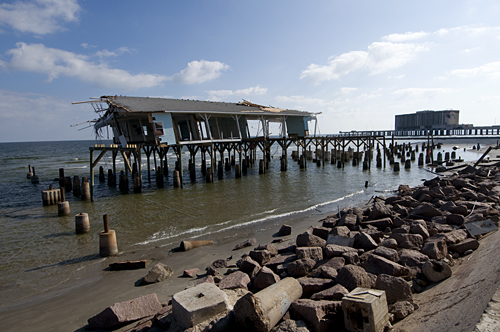
Erosion and Destruction
The mainstream media (MSM) is long gone – there were no masses, heck there was no one standing around begging for Uncle Sam to save them. There just wasn’t a story according to the MSM. If there were a story, some governmental slam slant, rest assured they would all still be here. Whether or not it’s a different sociology in Texas, or God forbid the government is working this time, history will be the judge and jury on that count.
Virtually all roads are passable now. Sand and debris that was on the roads forms sand dunes, dry but like driven snow slush one finds as the snow begins to melt – not attractive in any way. Some piles are pure wood, splinters and boats as the icing on top. Just out of normal eyesight are the gathering spots, where all the loads of debris are dumped. Giant backhoes on top spread and pile, spread and pile. On Galveston proper, the seawall did what it was built to do. It held the Gulf at bey and minimized the damage – essentially reducing an F2 hurricane to the damage an F2 would do to a properly protected city. But I was headed back to see if Earnie’s was still standing, and that was miles down the road and miles from the seawall. Mentally, I reformed the hurricane so that I could get a perspective on wind direction, the eye of the hurricane and the path of the stronger and weaker sides of the rotation. Earnie’s could either be all there, or it could be all gone. Ike left little room for anything in between.
I have also always had this thing about the “follow up” from my newspaper days. It is painfully obvious that typical newspapers and electronic media increasingly do little if any follow ups to disasters anymore. News served straight up, without a twist, is no longer the norm, and bean counters are running newsrooms.
If I was so fortunate to do a story from Galveston one week before this natural disaster, the least I could do is drive the extra miles back to report to those wanting to know what remains. Morbid curiosity? Perhaps, but with part three tomorrow, I can offer readers a distinct opportunity to actually participate in the recovery efforts underway in the area.
I headed off the seawall and down toward Earnie’s. As I dropped down to real Island level, the reality of the sea – at sea level – becomes more vivid. The sand piles along the sides of the road now reach up to ten feet in the air. Stilted houses have all the accrutrements of a home washed away. Cars, boats, plastic chairs, buckets and toys all cleared from their hallowed places and now poking out of the piles that stretch for miles and miles. All of the stilted houses seem to have weathered the storm as they were designed to do – 15 feet off the ground to allow the water to wash underneath, some may lean a little, but they are still there.

Toys washed from under their stilted homes and across the road.
Evidence of just how much beach was lost is evident from the beach houses’ private boardwalks that once slatted their way over now extinct sand dunes – sitting 15 or 20 feet in the air. The beach itself washed down to the hard sand and then decorated with seaweed and more debris.
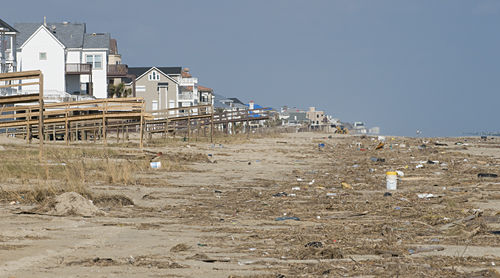
The Ike debris goes on for miles.
Finally, I hit the SLP bridge and there’s no one to take the two dollar toll. A trash bag sits outside the door, but for all intents and purposes, abandon ship. After I crested the bridge, I realized why; the other side was barricaded to traffic with “Warning Road is Out” signs. Cars were coming from that direction, so it couldn’t be that bad. By the time I got to the second washout, I knew I would never have enough time to reach Earnie’s and get back without a lot more time on the clock. The closest I got to Earnie’s that day was the photograph below.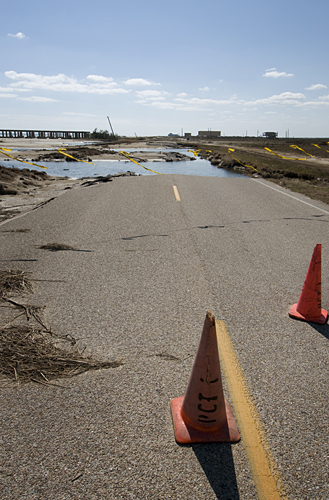
Road to Earnie’s Bait near the SLP.
With the extra time on my hands I made it back to Galveston and headed back off the Island. At the last minute, I saw a sign for the “Historic Strand” and backtracked into town along an industrial road that also leads to the cruise ships. It looks like some industries have seized the opportunity of free hauling and taken massive quantities of their resident trash and shoveled it out to the street. It’s to be expected isn’t it?
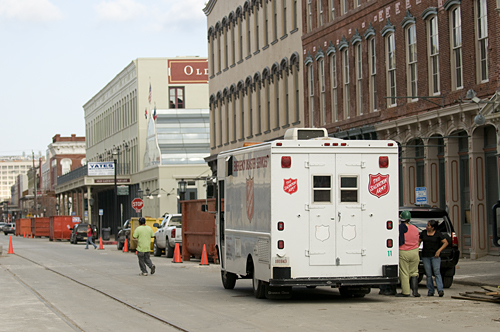
Downtown Galveston – a washout.
I was slightly familiar with the “Fisherman’s Wharf” restaurant on the water, and needless to say, they will not be serving soon. The old buildings in the downtown area have all apparently had their bottom floors washed out – therefore rendering the floors above inaccessible and uninhabitable. It looks like a ghost town with only the clean up crews and noise of portable generators and fresh air units droning on in a constant pitch. Salvation Army food trucks stop and serve, and continue threading their way through the debris, dumpsters, parked vehicles, cones and barricades. It looks like business owners have abandoned their businesses to the recovery, or maybe they have just gone home for the day. It’s getting late on a Friday afternoon.
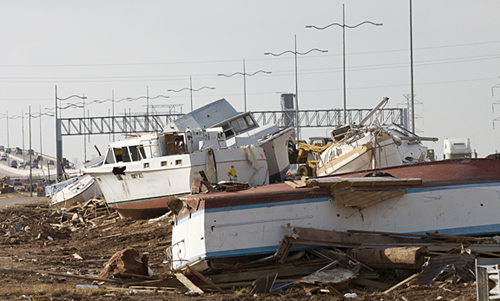
Bilge near the bridge.
I made my way back off the Island and toward Houston. Trucks with flatbed trailers loaded with used washers, dryers and refrigerators passed my Land Cruiser at warp speed. A repair truck passed by with a disturbing question in the back of it. It was loaded with a beautiful little old Boston Whaler (probably about 10 or 12 feet), and I was struck by the questions: Is that his Whaler? If it is, why isn’t it on a trailer? If it’s not, how in the heck did he find the owner and make a transaction in this disaster zone? And if it was his, why not just leave it where it was, or secure it on the spot? Looting? The government may be infusing millions, but the Island is still slowly bleeding out.
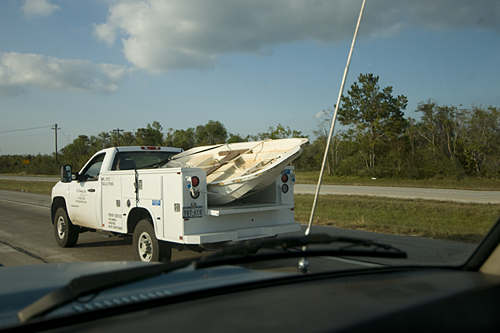
A sweet little Boston Whaler finds a new home?
Tomorrow, in Part 3, I will take a look at C.O.R.E. and their efforts on the mainland.

You must be logged in to post a comment.